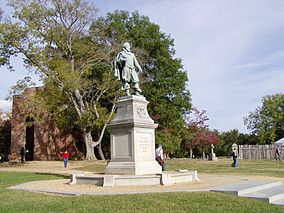
The Jamestown settlement in the Colony of Virginia was the first permanent English settlement in the Americas. It was located on the northeast bank of the James River, about 2.5 mi (4 km) southwest of the center of modern Williamsburg. It was established by the Virginia Company of London as "James Fort" on May 4, 1607 O.S., and was considered permanent after a brief abandonment in 1610. It followed several failed attempts, including the Lost Colony of Roanoke, established in 1585 on Roanoke Island, later part of North Carolina. Jamestown served as the colonial capital from 1616 until 1699. Despite the dispatch of more settlers and supplies, more than 80 percent of the colonists died in 1609–1610, mostly from starvation and disease. In mid-1610, the survivors abandoned Jamestown, though they returned after meeting a resupply convoy in the James River.

Jamestown Settlement is a living history museum operated by the Commonwealth of Virginia, created in 1957 as Jamestown Festival Park for the 350th anniversary celebration. Today it includes a recreation of the original James Fort, a Powhatan Native American town, indoor and outdoor displays, and replicas of the original settlers' ships: the Susan Constant, Godspeed, and Discovery.

James City County is a county located in the Commonwealth of Virginia. As of the 2020 census, the population was 78,254. Although politically separate from the county, the county seat is the adjacent independent city of Williamsburg.
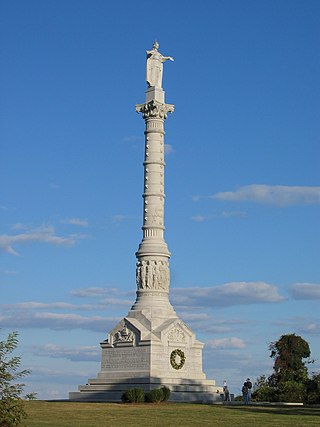
Colonial National Historical Park is a large national historical park located in the Hampton Roads region of Virginia operated by the National Park Service. It protects and interprets several sites relating to the Colony of Virginia and the history of the United States more broadly. These range from the site of the first English settlement at Jamestown, to the battlefields of Yorktown where the British Army was defeated in the American Revolutionary War. Over 3 million people visit the park each year.

The Popham Colony—also known as the Sagadahoc Colony—was a short-lived English colonial settlement in North America. It was established in 1607 by the proprietary Plymouth Company and was located in the present-day town of Phippsburg, Maine, near the mouth of the Kennebec River. It was founded a few months after its more successful rival, the colony at Jamestown. That colony was established on May 4, 1607 by the London Company in present-day James City County, Virginia.

Jamestown Island is a 1,561-acre island in the James River in Virginia, part of James City County. It is located off Glasshouse Point, to which it is connected via a causeway to the Colonial Parkway. Much of the island is wetland, including both swamp and marsh.

Founded in 1889, the Association for the Preservation of Virginia Antiquities was the United States' first statewide historic preservation group. In 2003 the organization adopted the new name APVA Preservation Virginia to reflect a broader focus on statewide Preservation and in 2009 it shortened its name to Preservation Virginia. Preservation Virginia owns historic sites across Virginia including Historic Jamestowne, located at Jamestown, Virginia, site of the first permanent English settlement in North America, and the Cape Henry Light house, one of the first public works projects of the United States of America.
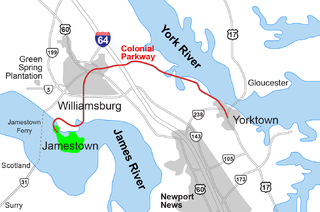
The Historic Triangle includes three historic colonial communities located on the Virginia Peninsula of the United States and is bounded by the York River on the north and the James River on the south. The points that form the triangle are Jamestown, Colonial Williamsburg, and Yorktown. They feature many restored attractions and are linked by the Colonial Parkway in James City and York counties, and the City of Williamsburg.

Jamestown 2007 is the name of the organization which planned the events commemorating the 400th anniversary (quadricentennial) of the founding of Jamestown, Virginia in 1607, the first permanent English-speaking settlement in what is now the United States of America. America's 400th Anniversary was an 18-month-long commemoration including 10 Signature Events, hundreds of community programs and dozens of partner and programs and events. Activities took place throughout Virginia, in major cities along the East Coast, and in the United Kingdom.
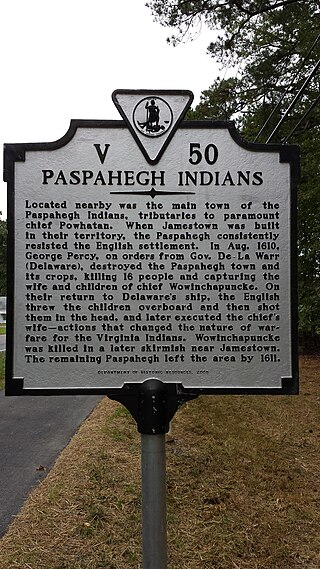
The Paspahegh tribe was a Native American tributary to the Powhatan paramount chiefdom, incorporated into the chiefdom around 1596 or 1597. The Paspahegh Indian tribe lived in present-day Charles City and James City counties, Virginia. The Powhatan Confederacy included Indigenous peoples of the Northeastern Woodlands who spoke a related Eastern Algonquian languages.
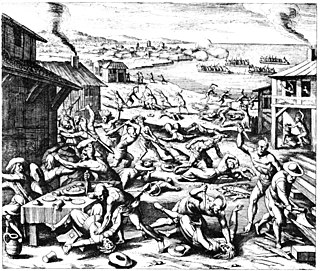
The Indian massacre of 1622 took place in the English colony of Virginia on 22 March 1622. English explorer John Smith, though he was not an eyewitness, wrote in his History of Virginia that warriors of the Powhatan "came unarmed into our houses with deer, turkeys, fish, fruits, and other provisions to sell us"; they then grabbed any tools or weapons available and killed all English settlers they found, including men, women, and children of all ages. Opechancanough, chief of the Powhatan Confederacy, led a coordinated series of surprise attacks that ended up killing a total of 347 people — a quarter of the population of the Colony of Virginia.

The Anglo–Powhatan Wars were three wars fought between settlers of the Colony of Virginia and the Powhatan People of Tsenacommacah in the early 17th century. The first war started in 1609 and ended in a peace settlement in 1614. The second war lasted from 1622 to 1632. The third war lasted from 1644 until 1646 and ended when Opechancanough was captured and killed. That war resulted in a defined boundary between the Indians and colonial lands that could only be crossed for official business with a special pass. This situation lasted until 1677 and the Treaty of Middle Plantation which established Indian reservations following Bacon's Rebellion.
The Starving Time at Jamestown in the Colony of Virginia was a period of starvation during the winter of 1609–1610. There were about 500 Jamestown residents at the beginning of the winter; by spring only 61 people remained alive.
Robert Hunt, a vicar in the Church of England, was chaplain of the expedition that founded the first successful English colony in the New World, at Jamestown, Virginia, in 1607.

Jamestown Rediscovery is an archaeological project of Preservation Virginia investigating the remains of the original English settlement at Jamestown established in the Virginia Colony in North America beginning on May 14, 1607.
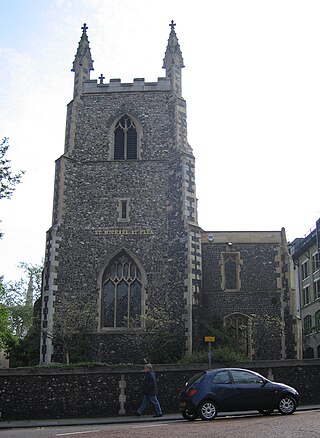
William Capps was born in Norfolk, England in or around 1575. William married Catherine Jernagin in Norwich, Norfolk, England, 11-Dec-1596, at St. Michael at Plea. He and his wife had five children together: Henry, Frances, Willoughby, Anne, and William.

Jamestown Church, constructed in brick from 1639 onward, in Jamestown in the Mid-Atlantic state of Virginia, is one of the oldest surviving building remnants built by Europeans in the original Thirteen Colonies and in the United States overall. It is now part of Historic Jamestown, and is owned by Preservation Virginia. There have been several sites and stages in the church's history, and its later tower is now the last surviving above-ground structure from the days when Jamestown was the capital of Virginia. The current structure, active as part of the Continuing Anglican movement, is still in use today. The ruins are currently being researched by members of the Jamestown Rediscovery project.

Jamestown, also Jamestowne, was the first settlement of the Virginia Colony, founded in 1607, and served as the capital of Virginia until 1699, when the seat of government was moved to Williamsburg. This article covers the history of the fort and town at Jamestown proper, as well as colony-wide trends resulting from and affecting the town during the time period in which it was the colonial capital of Virginia.
William Spence was an early Virginia colonist on Jamestown Island. He was member of the first assembly of the Virginia House of Burgesses in Jamestown, Virginia in 1619. Spence became an ensign in the local militia and is thus sometimes identified as Ensign William Spence or Ensign Spence. He was an early farmer on Jamestown Island, a tobacco taster and landowner at Archer's Hope. He, his wife and his young daughter, Sara, or Sarah, avoided the Indian massacre of 1622, but Spence and his wife were reported "lost" at the census of February 16, 1624.
William Spencer was an early Virginia colonist on Jamestown Island, who was an Ancient planter and a member of the Virginia House of Burgesses in Jamestown, Virginia for Mulberry Island in 1632/33.
